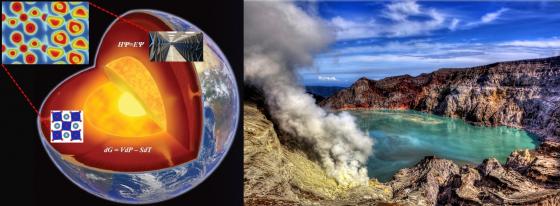Geothermics
The main topics of this research are the determination and study of the terrestrial heat flow and its relationship to tectonics, the circulation of underground fluids and geothermal resources. The geophysical methodologies adopted are both theoretical and experimental and aim to improve the knowledge on heat transfer processes as well as the structure of onshore and offshore geothermal systems. Analyzing the temperatures measured in the subsoil, the thermal and physical properties (like the thermal conductivity, electrical resistivity, density and magnetization) and the heat flow data allows the recognition of the type of thermal regime and constraining the conceptual models of geothermal systems. These issues are thus crucial not only for modelling crustal and lithospheric thermal structures but also for renewable energy applications. The study of the subsoil thermal state, the thermophysical and physical properties is, in fact, fundamental also in terms of geothermal energy resources. This sustainable and renewable resource is becoming increasingly attractive in its various technical aspects (electrical and direct uses, geothermal heat pumps, ...). (E. Armadillo, F. Caratori Tontini, M. Verdoya)
Submarine volcanoes and hydrothermal systems
A significant amount of heat and chemicals is moved between the Earth's lithosphere, hydrosphere, and biosphere at submarine hydrothermal vents. Despite being very small environments compared to the global area of the ocean floor, they are estimated to contribute ~25% of the Earth's total geothermal output by venting acidic fluids up to 400 °C, where chemosyntesis supports unique biologic communities. In this process, vast amounts of metallic minerals are deposited on the seafloor. The main topics are:
- High-resolution studies of active systems in the Kermadec Arc and the Tyrrhenian Sea by multidisciplinary geophysical surveys and development of novel interpretation algorithms, in collaboration with national (e.g., Istituto Nazionale di Geofisica e Vulcanologia) ed international (e.g., GNS Science) partners. (F. Caratori Tontini)
- Mineralization studies of the Ligurian ophiolites and their tectono-matamorphic evolution, in particular Mn, critical metals and VMS deposits with Cu-Fe sulphides originated in the Tethis Basin from analogue hydrothermal circulation processes altering oceanic crust (D. Belmonte, R. Cabella, C. Carbone, P. Marescotti)
Thermodynamic and physico-chemical properties of deep Earth minerals
Physico-chemical and thermodynamic properties of deep Earth materials are crucial to understand the dynamics and chemical evolution of our planet and planetary bodies. The main goal of this research is to gain original insights on the following topics:
- Thermodynamic properties and stability relations of minerals, melts and fluids at deep Earth conditions by ab initio calculations (DFT, molecular dynamics) and computational modelling
- Phase diagrams at extreme P-T conditions by computational thermodynamics
- Elastic properties and phase transitions at HP-HT
- Melting and solid-melt-fluid phase equilibria in the deep Earth and planetary interiors
The research is developed in collaborations with national and international institutions (CNR-SCITEC Milan, IPGP – Institut de Physique du Globe de Paris, IMPMC - Institute de Minéralogie, de Physique des Matériaux et de Cosmochimie, Sorbonne Université, Paris) and supported by PRIN-MUR and CINECA HPC projects (ISCRA, Italian SuperComputing Resource Allocation). (D. Belmonte)

